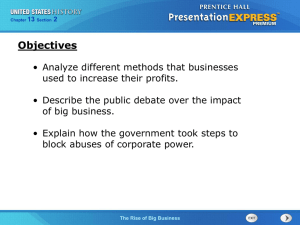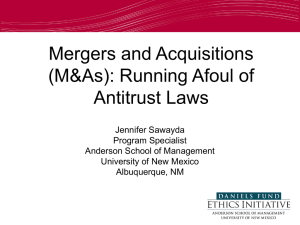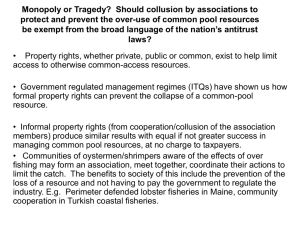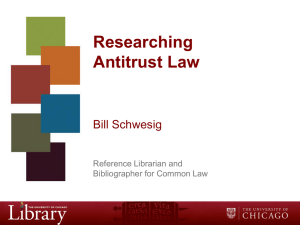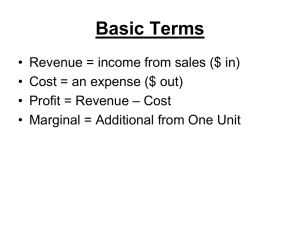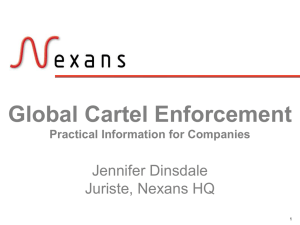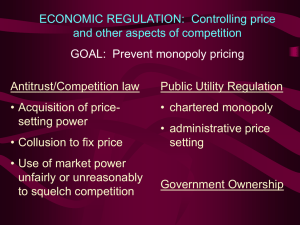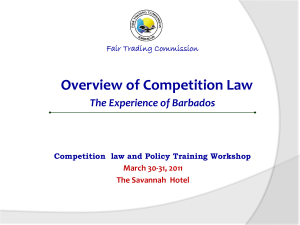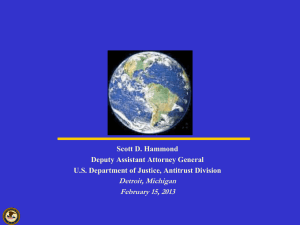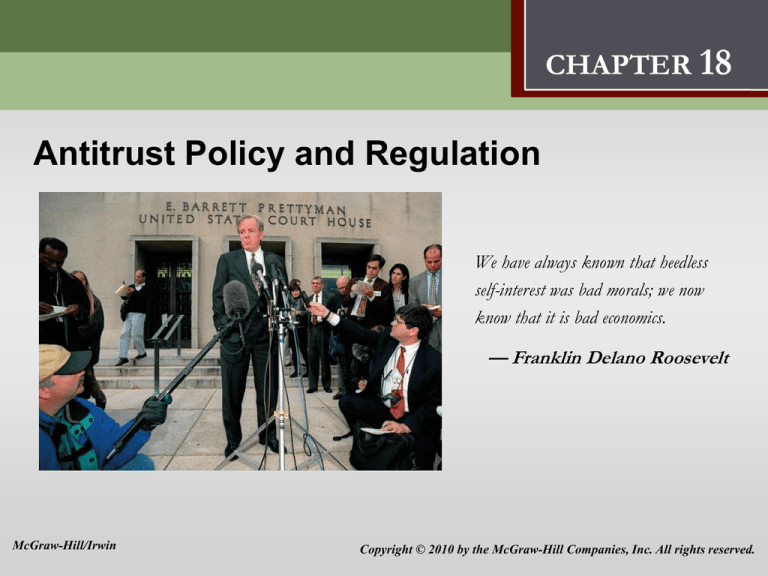
Antitrust Policy
and Regulation
18
CHAPTER 18
Antitrust Policy and Regulation
We have always known that heedless
self-interest was bad morals; we now
know that it is bad economics.
— Franklin Delano Roosevelt
McGraw-Hill/Irwin
Copyright © 2010 by the McGraw-Hill Companies, Inc. All rights reserved.
Antitrust Policy
and Regulation
18
Chapter Goals
• Explain the difference between the structure and
the performance methods of judging competition
• Outline a brief history of U.S. antitrust policy
• Discuss the resolution of the IBM, AT&T, and
Microsoft antitrust cases
• Differentiate among horizontal, vertical, and
conglomerate mergers
18-2
Antitrust Policy
and Regulation
18
Chapter Goals
• Discuss the five reasons why unrelated firms would
want to merge
• Compare U.S. antitrust policy with antitrust policy of
other countries
• Explain three alternatives to antitrust policy that
government can use to affect the competitive process
18-3
Antitrust Policy
and Regulation
18
Antitrust Policy:
Judgment by Performance or Structure?
• Antitrust policy is the government’s policy toward the
competitive process
• There are two competing views of competition:
• Judgment by performance: We should judge
the competitiveness of markets by the behavior
(performance) of the firms in the market
• Judgment by structure: We should judge the
competitiveness of markets by the structure of
the industry
18-4
Antitrust Policy
and Regulation
18
History of U.S. Antitrust Laws
• Americans generally favor laissez-faire, but populist
sentiment fears bigness and monopoly
• A trust or cartel is a combination of firms that have not
actually merged, but act as a single entity to set common
prices and govern the output of individual member firms
• A trust often acts like a monopoly
• Cartels and trusts, which developed during the late 1800s,
led to the passage of the Sherman Act, the Clayton Act,
and the Federal Trade Commission Act
18-5
Antitrust Policy
and Regulation
18
The Sherman Antitrust Act
• The Sherman Antitrust Act of 1890 was a law designed
to regulate the competitive process
• The two main provisions of the Act were:
1. “Every contract, combination, or conspiracy in
restraint of trade is illegal”
2. “Every person who shall monopolize…shall be
deemed guilty of a misdemeanor”
• The act was broad and sweeping, but vague
18-6
Antitrust Policy
and Regulation
18
The Sherman Antitrust Act
• In the 1890s, economists debated if:
• Mergers reflected increased economies of scale
• Mergers were attempts to restrict output and
generate monopoly profits
• Competition was strong enough to limit monopolies
• Trusts should be broken up by the government
18-7
Antitrust Policy
and Regulation
18
Application:
The Standard Oil and American Tobacco Cases
Examples of judging market competitiveness by performance
• A firm is considered a monopoly only if it commits
monopolistic abuses
• In 1911 the Supreme Court found Standard Oil and the
American Tobacco Company, both structural monopolies,
guilty of unfair business practices and were broken up
• In the 1920 U.S. Steel case, the Court ruled that while the
company was a structural monopoly, it was not a
monopoly in performance
• U.S. Steel was not required to break up into
smaller companies
18-8
Antitrust Policy
and Regulation
18
The Clayton Act
The Clayton Antitrust Act of 1914 made four monopolistic
practices illegal when their effect was to lessen competition:
1. Price discrimination
2. Tie-in contracts
3. Interlocking directorships
4. Purchase of a competitor’s stock
18-9
Antitrust Policy
and Regulation
18
The Federal Trade Commission Act
• The Federal Trade Commission Act of 1914 made it
illegal:
1. To use “unfair methods of competition”
2. To engage in “unfair or deceptive acts or
practices”
… whether or not those actions had any effect on
competition
• In 1938 the Federal Trade Commission was given the
job of preventing false and deceptive advertising
18-10
Antitrust Policy
and Regulation
18
Application: The ALCOA Case
Examples of judging market competitiveness by structure
• Judgment by performance governed antitrust policy
until the ALCOA case of 1945
• The court did not rule that ALCOA had engaged in
unfair practices, but that it dominated the market by
expanding capacity and keeping prices low
• The court changed its viewpoint to judging markets by
structure
18-11
Antitrust Policy
and Regulation
18
Judging Markets by Structure or Performance:
The Reality
• Judging by structure is practical though seemingly unfair
• If a firm is competing so successfully that all the
other firms leave the industry, the successful firm
will be a monopolist
• With judgment by performance, each action of a firm
must be analyzed on a case-by-case basis, which is
difficult to do
• Judging by structure may have problems, but it is
necessary
18-12
Antitrust Policy
and Regulation
18
Determining the Relevant Market and Industry
• Choosing the relevant market when evaluating
competitiveness is difficult to do
• The relevant industry in the ALCOA case was the
aluminum industry, not the metals industry at large
• The relevant industry in the Du Pont case (1956) was
flexible wrap including aluminum foil and wax paper,
not cellophane
• Du Pont was not considered a monopolist even
though it sold 100% of cellophane
• Mergers are also scrutinized
18-13
Antitrust Policy
and Regulation
18
Recent Antitrust Enforcement
• Since the 1980s, the government has been more lenient
in antitrust cases because of:
• Change in the American ideology
• Globalization of the U.S. economy
• The increasing complexity of technology
• There have been three recent important computer and
telecommunications cases:
1. IBM
2. AT&T
3. Microsoft
18-14
Antitrust Policy
and Regulation
18
The IBM Case
• In 1967, the Justice Department sued IBM for violation
of antitrust laws:
• IBM unfairly bundled hardware, software, and
maintenance service
• IBM constantly redesigned its hardware, so that
competitors couldn’t keep up
• In its defense, IBM argued:
• The market was larger than the government claimed
• Changing technology and customer demand forced
it to constantly upgrade its equipment
18-15
Antitrust Policy
and Regulation
18
The IBM Case
• The government dropped its suit in 1982
• Mainframe computers were replaced by PCs
• Globalization of the computer industry made IBM’s
dominance in the U.S. far less important
• The prosecution likely led to IBM’s problems in the 1990s
• IBM didn’t buy the DOS operating system from
Microsoft because of the litigation
• PCs replaced mainframes
18-16
Antitrust Policy
and Regulation
18
The AT&T Case
• Up until 1982, AT&T was a regulated natural monopoly
• It controlled most long-distance and local
telephone services
• It produced telephones and other communications
equipment
• Satellite transmissions and fiber-optic cable began to
compete for long-distance service
• Competitors sued because they felt AT&T was charging
too much to access its local lines
18-17
Antitrust Policy
and Regulation
18
The AT&T Case: Resolution
• In 1982, AT&T agreed to divest its 22 local operating
companies, which merged into the seven Baby Bells
• It kept its long-distance telephone service, manufacturing
arm, and Bell Laboratories
• Other firms emerged as long-distance competitors and
rates fell
• Local rates doubled and tripled
18-18
Antitrust Policy
and Regulation
18
Developments Since the AT&T Case
• By 2005 the Baby Bells had merged into four companies:
SBC Communications, Verizon, Bell South, and Qwest
• In 1995, AT&T had divided itself into three companies:
AT&T, Lucent, and National Cash Register
• In 2005, AT&T and SBC Communications (Cingular
Wireless) merged as a new AT&T
• Finally in 2006, the new AT&T was taken over by Bell
South to become the new, new at&t
18-19
Antitrust Policy
and Regulation
18
The Microsoft Case
• Microsoft controls about 50% of the market for software
and over 90% of the operating systems market
• In 1998, the Justice Department charged Microsoft with:
1. Possessing monopoly power in the PC operating
systems market
2. Tying other Microsoft software products to its
Windows operating system
3. Entering into agreements that keep computer
manufacturers that install Windows from offering
competing software
18-20
Antitrust Policy
and Regulation
18
The Microsoft Case
Is Microsoft a monopolist?
• The software industry is characterized by barriers to entry
in the form of:
• Network externalities
• Economies of scale
• In a static framework
• With its 90% market share, Microsoft is a monopoly
• From a dynamic perspective
• There is potential competition from other operating
systems and the merging of hardware and software
18-21
Antitrust Policy
and Regulation
18
The Microsoft Case
Is Microsoft a Predatory Monopolist?
• The Justice Department argued that Microsoft had acted
unfairly in gaining its large share of the software market
and maintaining barriers to entry
• By directing the development of software to favor
Windows, Microsoft strengthened the barrier to entry
created by network externalities
• Microsoft penalized PC manufacturers that installed
Windows if they also installed competing software
18-22
Antitrust Policy
and Regulation
18
The Microsoft Case: Resolution
• In 2000 the court ruled that Microsoft violated the
Sherman Act by using anti-competitive means to maintain
its monopoly power
• In the settlement Microsoft agreed that:
• It would not prohibit PC makers from using
competing products
• It would release technical information on Windows
improvements to software makers
• It could continue to bundle e-mail and media
players with Windows
18-23
Antitrust Policy
and Regulation
18
Microsoft, the European Union, and the Internet
• While Microsoft was negotiating with regulators in the U.S.,
it also faced antitrust investigation in the EU
• The EU has fined Microsoft repeatedly for antitrust violations
• In 2007, technology had changed and Microsoft now faces
competition from free software offered by Google online
18-24
Antitrust Policy
and Regulation
18
Assessment of U.S. Antitrust Policy
• Economic scholars’ overall assessment of antitrust policy
is mixed
• In certain cases, such as the IBM case, most agree that
antitrust prosecution went too far
• Most believe that other decisions (as in the Standard Oil
and American Tobacco cases) set a healthy precedent
by encouraging a more competitive U.S. business
environment
18-25
Antitrust Policy
and Regulation
18
Mergers, Acquisitions, and Takeovers
• During the 1990s and early 2000s, firms have been
breaking up and merging to achieve economies of scope
and economies of scale
• A merger is a general term meaning the act of combining
two firms, may occur as:
• Takeovers which are the purchase of one firm by
a shell firm that then takes direct control of all the
purchased firm’s operations
• Acquisitions which are transactions in which a
company buys another company and the purchaser
has the right of direct control over the resulting
operation (but does not always exercise that right)
18-26
Antitrust Policy
and Regulation
18
Mergers
• A horizontal merger is the merging of two companies in
the same industry
• Standard Oil, AT&T and Cingular are examples
• A vertical merger is a combination of two companies that
are involved in different phases of producing a product
• An example is the DuPont/General Motors case
• A conglomerate merger is the merging of two companies
in relatively unrelated industries
• Tyco is an example of a conglomerate merger
18-27
Antitrust Policy
and Regulation
18
Reasons for Mergers
Five reasons unrelated firms combine are:
1. To achieve economies of scope
2. To get a good buy
3. To diversify
4. To ward off a takeover bid
5. To strengthen their political-economic influence
18-28
Antitrust Policy
and Regulation
18
Recent Merger Activity
• Mergers rose significantly in the late 1990s and into the
early 2000s
• The primary reasons for the increase are globalization,
deregulation, and technological change
• At the same time that these mergers are taking place,
firms are also engaging in deacquisitions when one
company’s sale of either parts of another company it has
bought or parts of itself
• The U.S. market structure is a continually changing
landscape
18-29
Antitrust Policy
and Regulation
18
International Competition and
Antitrust Policy in Other Countries
• When people talk about competition, they often mean
international competition
• More and more, U.S. antitrust policy makers see the
international market as the relevant
• The European Commission (EC), the EU’s antitrust
agency, favors a strong European antirust policy
• Given the ongoing globalization of markets, we can expect
more and more jurisdictional legal battles in antitrust policy
18-30
Antitrust Policy
and Regulation
18
Sovereign Wealth Funds
• A recent institutional change with important market
structure effects is the establishment of sovereign
wealth funds which are investment funds held by
governments
• A number of governments with large trade and budget
trade surpluses are accumulating assets in several
wealth funds
• New rules will be developed about what companies
sovereign wealth funds can own, and what role they
can play in voting the stock that they do own
18-31
Antitrust Policy
and Regulation
18
Regulation, Government Ownership,
and Industrial Policies
Governments can affect the competitive process by:
• Regulating the activities of firms with:
• Price regulations, regulation directed at industries
that have natural monopoly elements
• Social regulations that affect aspects such as
working conditions and product quality
• Owning and taking charge of the firms and controlling them
directly
• Industrial policy is a formal policy that governments take
towards business
• Influences firms with laws and taxes
18-32
Antitrust Policy
and Regulation
18
Chapter Summary
• Antitrust policy is the government’s policy toward the
competitive process
• The competitiveness of markets can be judged by:
• Performance – behavior of firms in the market
• Structure – number of firms in the industry and
their market share
• Important antitrust laws include:
• The Sherman Antitrust Act
• The Clayton Act
• The Federal Trade Commission Act
18-33
Antitrust Policy
and Regulation
18
Chapter Summary
• Important antitrust cases involved:
• AT&T
• IBM
• Microsoft
• Three types of mergers are:
• Horizontal – two firms in the same industry
• Vertical – two companies in different industries,
one of which is a supplier for the other
• Conglomerate – combination of two companies
in relatively unrelated industries
18-34
Antitrust Policy
and Regulation
18
Chapter Summary
• Reasons unrelated firms would want to merge are:
• To achieve economies of scope
• To get a good buy
• To diversify
• To ward off a takeover bid
• To strengthen their political-economic influence
18-35
Antitrust Policy
and Regulation
18
Chapter Summary
• The increasing internationalization of the U.S. market
has changed U.S. antitrust policy from looking at just
domestic competition to considering international
competition
• Antitrust issues are by nature global, but a country’s
antitrust laws are not
• Other than antitrust policy, government affects the
competitive process through regulation, government
ownership, and industrial policy
18-36
Antitrust Policy
and Regulation
18
Preview of Chapter 19:
Work and the Labor Market
• Use the theory of rational choice to explain why an increase in the
marginal tax rate is likely to reduce the quantity of labor supplied
• Discuss four factors that influence the elasticity of market labor supply
• Discuss four factors that influence the elasticity of market labor demand
• Explain how the demand for labor is a derived demand
• Define monopsony and bilateral monopoly
•
Explain real-world characteristics of labor markets in terms of market,
political, and social forces
• Discuss three types of discrimination
18-37

